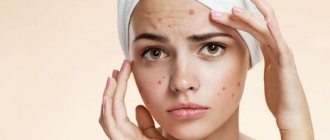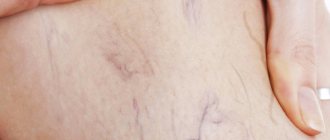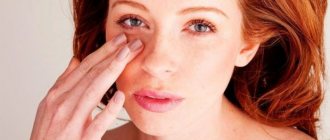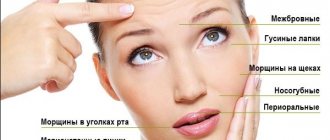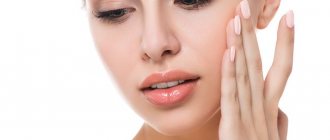Causes of redness on the face and body
Conditions that cause redness of the skin are divided into physiologically determined and pathological. In the first case, we are talking about normal conditions that do not indicate a particular disease. In the second case, redness of the skin may be a sign of a pathological process.
Among the physiologically determined prerequisites for skin redness are:
- Reaction to low or high ambient temperature.
- Redness of the skin caused by joy, embarrassment, shame.
- Performing physical activity.
Among the causes of pathological hyperemia of the skin are the following:
- Allergic reactions.
- Dermatological diseases.
- Systemic diseases.
- Infectious diseases.
- Cuperosis.
- Increased body temperature, high blood pressure.
- Reactions to stress.
- Side effect of certain medications.
- Reactions to an insect bite.
Causes of hyperemia
Redness on the face is a clear and common sign of hyperemia.
Under the influence of external and internal factors, blood vessels dilate, which increases blood flow to the skin and leads to a change in their color. This is especially noticeable in people with fair and sensitive skin. Red spots on the face can appear for various reasons:
- Temporary stimuli . Among them are changes in external temperatures and wind, physical and emotional stress, sunburn or mechanical factors (friction, pressure). Redness of the skin can be caused by side effects of medications, incorrectly selected cosmetics and some types of caring procedures: peeling, resurfacing, microcurrent therapy.
- Physiological conditions.
Hormonal changes are often accompanied by systemic reactions, including skin reactions. Situations when red spots appear on the face cause psychological discomfort during puberty, pregnancy, menopause, etc. - Allergic and toxic agents.
They can enter the body through the gastrointestinal tract, respiratory tract, injection and contact (by direct contact with the skin). - Pathological conditions.
This is a large group of acute and chronic diseases, both of a purely dermatological and general nature, namely: disruption of the cardiovascular system and the hematopoietic mechanism; - acute infectious diseases and inflammatory processes in the body;
- damage to the gastrointestinal tract;
- pathology of ENT organs;
- endocrine and autoimmune diseases;
- disorders of the central and peripheral nervous system;
- dermatoses of various origins.
In such situations, it is possible to remove redness from the face only by simultaneously addressing the root cause and the symptom. Even true dermatological disorders are difficult to correct without improving the health of the whole organism.
What is better: ointment or cream for redness on the face?
The choice of external remedy to eliminate redness should be based on the causes of hyperemia and the presence of accompanying symptoms. For example, if erythema is caused by an inflammatory process affecting the deeper layers of the skin, it is recommended to use ointment. It ensures deeper penetration of active components into the skin. The same applies to treating excessively dry, reddened areas of the skin. However, if redness of the skin is accompanied by the presence of weeping wounds, the use of ointments is not recommended.
Cream for skin redness is usually used in cases where it is necessary for the product to be absorbed as quickly as possible and not leave a sticky or greasy film on the skin. Usually the cream is used for application to the face.
Cream for redness on the face and body: list of popular ingredients
The composition of products designed to combat redness on the nose, cheeks, neck and other parts of the body may vary. Common components include:
- Hyaluronic acid. Many creams for sensitive skin prone to redness contain hyaluronic acid. This substance helps moisturize the skin, stimulates the renewal of damaged cells, takes part in the production of collagen and elastin, and has anti-inflammatory properties.
- Collagen. In addition to the fact that this protein complex is necessary to maintain skin tone and elasticity, it also affects its pigmentation. A lack of natural collagen leads to discoloration of the skin.
- Panthenol. Panthenol is an essential component of most soothing face creams against redness. Absorbed into the skin, it is converted into pantothenic acid, which has a huge effect on skin regeneration, reducing inflammation and redness.
- Glycolic acid. This substance has a positive effect on cellular renewal processes, helps normalize the color of the skin, making it softer and more elastic.
- Allantoin. Allantoin is known for its regenerating, bactericidal and antioxidant properties. This substance evens out skin color, perfectly moisturizes and nourishes it, relieves irritation and redness.
- Glycerol. Many creams for redness and flaking of facial skin contain glycerin. This substance helps soften and moisturize the skin. Because of this, glycerin is often used to combat redness that appears on dry and sensitive skin.
- Plant extracts, base and essential oils. Plant components perfectly soothe irritated skin, relieve inflammation and normalize skin color. External products may include white and green tea, extracts of chamomile, calendula, aloe vera, shea butter, jojoba, wheat germ, almond, olive and castor, as well as essential oils of tea tree, lavender, mint.
- Bee products. Royal jelly, propolis, honey - they all have a positive effect on the condition of the skin. They contain a huge list of valuable amino acids, vitamins and minerals. This is why creams against redness on the face often contain beekeeping products. However, it must be borne in mind that they can cause allergies, so such products are not recommended for people who are hypersensitive to honey.
- Cosmetic clay. The cream for red spots on the face may contain cosmetic clay - white, pink, blue, green, black. Each type of clay has its own properties and characteristics, but almost all of them help reduce inflammation and even out skin color.
Treatment of allergies to cosmetics
Therapy for an allergic reaction involves stopping contact with the allergen substance. If, after applying the product, signs of allergy appear on your facial skin, you should rinse it thoroughly with warm water. Before contacting a doctor, you should take any of the antihistamines that are available in your home medicine cabinet, for example Cetrin®.
Cetrin® is a 2nd generation drug that has a long-lasting therapeutic effect. Back in 2002, it was named the most popular drug, and today confidence in Cetrin® is still at a high level3.
Rules for taking and dosage of the drug Cetrin® when symptoms of an allergic reaction appear:
- children over 6 years old should take ½ tablet twice a day or 1 tablet once a day;
- Adults should use 1 tablet once a day.
Patients with reduced kidney function are prescribed ½ tablet per day, and people with severe chronic renal failure need to take ½ tablet every other day.
The tablet must not be chewed. It must be washed down with 200 ml of water. Taking the drug does not depend on food intake4.
Further use of cosmetics until the causes of the reaction are clarified is contraindicated. After allergy symptoms have subsided, patch tests for allergens are taken. Based on the results, further treatment is prescribed.
Bibliography
- Novik G. Allergy. Immune system / G. Novik, A. Nikanorova. – M.: St. Petersburg, Trade and Publishing House “Amphora”, 2015. – 64 p.
- Cosmetology / ed. L.A Hejazi. – M.: Moscow, Italian Cosmetology, 2005. – 197 p.
- Vertkin A. L. Acute allergic diseases: methodological. recommendations / A.L. Vertkin, K.K. Turlubekov, A.V. Dadykina. – M.: Department of Clinical Pharmacology of the State Educational Institution of Higher Professional Education “Moscow State Medical and Dental University” and NNPOSMP, 2005. – 24 p.
- Instructions for use of the medicinal product for medical use Cetrin®. – Registration number: P N013283/01.
Cream for redness on the face and body La-Cri
Depending on the type and condition of your skin, you can choose the appropriate La-Cri product:
- La-Cri cream for dry skin. The product effectively combats redness, peeling and itching of the skin, moisturizes and nourishes it. It contains shea butter, wheat germ and jojoba oils, string and licorice extracts, as well as beeswax.
- La-Cri cream for sensitive skin. If you suffer from periodic rashes accompanied by redness, itching and inflammation, this remedy will help you solve these problems. It contains extracts of string, violet and walnut, panthenol, bisabolol and avocado oil, which have a beneficial effect on the condition of the skin.
Cream selection criteria
Before purchasing a cream, you need to not only familiarize yourself with its composition, but also select it individually , taking into account a number of criteria and external characteristics:
- Taking into account your skin type is the most important thing in choosing cosmetics. There are five types in total: combination, dry, normal, problematic and sensitive. Taking into account your skin type, the cream will contain the required amount of certain important components;
- The age criterion is also important, since different active substances are included for different age groups. And also, the degree of hydration depends on this;
- The packaging must be intact, there must be a production date and expiration date, barcode, composition and other important features of the product;
- Value for money.
Clinical researches
The effectiveness, safety and tolerability of La-Cri products have been clinically proven. The products are recommended by the Union of Pediatricians of Russia. During clinical studies, specialists were able to record impressive results.
It has been proven that La Cree cream for dry skin:
- eliminates dryness and flaking;
- retains the skin's own moisture;
- protects skin from wind and cold.
In addition, it has been clinically proven that La Cree cream for sensitive skin:
- reduces itching and irritation;
- relieves skin redness;
- moisturizes and gently cares for the skin.
Sources:
- Baumann Leslie, Cosmetic Dermatology. Principles and practice, MEDpress-inform, 2016.
- Ratner Desiri, Avram M.R., Avram M.M., Procedures in Dermatology. Clinical cosmetology, GEOTAR-Media, 2022.
- Sukolin Gennady Ivanovich, Clinical dermatology. A short guide to the diagnosis and treatment of dermatoses, Notabene, 2017.
What causes skin redness during rosacea?
Manifestations of rosacea increase with vascular and immune disorders, gastrointestinal dysfunction, exposure to climatic factors, and emotional stress. The course of rosacea is aggravated by cosmetics and cleansers that have an irritating effect (waterproof cosmetics and toning preparations, the removal of which requires the use of solvents, as well as cleansers containing soap). Therefore, the basis of daily skin care for rosacea is recommended:
- gentle skin cleansing
- supporting the natural balance of healthy skin microflora
- moisturizing and protecting the skin from the sun
- control of dilated vessels.
